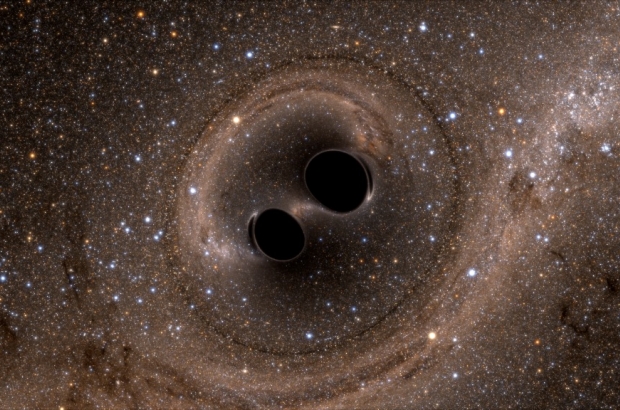- Daily & Weekly newsletters
- Buy & download The Bulletin
- Comment on our articles
KU Leuven researchers explain the finding that changed astronomy forever
On 14 September 2015, sensors at the twin Ligo laser interferometer observatories in the United States detected a slight wavelength shift in the lasers running through the vacuum sealed tubes inside each facility. The change was recorded and, over the next several months, scientists the world over, including those at KU Leuven’s Institute of Astronomy, tried to make sense of the data.
It turns out the wavelength shift was an echo of two black holes crashing into each other over a billion years ago in a remote corner of the universe. But when the signal was converted to sound here on Earth, the massive collision resembled a fleeting chirp.
And it could have been easily missed, had it not been for Ligo’s precise instruments that can detect shifts of less than 1/10,000th of the width of an atom. “We were very lucky,” says Gijs Nelemans, a Dutch astronomer at KU Leuven, who was involved in the discovery.
Nelemans, who splits his time between KU Leuven and Radboud University in Nijmegen, the Netherlands, was part of a team that interpreted the laser shift. The gravitational wave that caused it was faint and lasted for a fraction of a second, but the findings shook the scientific community the world over.
Ripples in space
A press conference to announce the discovery saw scores of reporters and scientists hone in on Washington, DC, in February. “The discovery is a beautiful confirmation of Einstein’s theory,” Nelemans explains.
When Einstein came up with his theory of general relativity back in 1915, he speculated that cosmic events of extreme proportions had to produce some kind of ripples in space, much like a child running around on a trampoline. The theory was revolutionary at the time, but another century would have to pass before someone – or something – could provide observational proof.
Ligo’s inconspicuous interferometers – located in Livingston, Louisiana, and in Hanford, Washington – bounce laser beams between mirrors at the opposite ends of perpendicular, four-kilometre-long vacuum pipes. If a gravitational wave were to pass through, it would alter the length of the pipes in different ways, causing the laser beams to shift slightly out of sync. And that is exactly what happened last September.
Based on the signals, Ligo scientists, working in tandem with the Flemish team at KU Leuven’s Institute of Astronomy, estimated that the detected gravitational wave resulted from a collision of two black holes – one 29 and the other 39 times the mass of our Sun. The resulting massive black hole, located 1.3 billion light years from Earth, was 62 times the mass of the Sun, but, in a fraction of second, about three times the mass of the sun escaped.
“These three Sun masses were transformed into energy, which radiated into the universe,” Nelemans explains. “Part of this radiation formed the gravitational waves that were detected at Ligo.”
According to Chris Van Den Broeck, a Flemish researcher working at the National Institute for Subatomic Physics in the Netherlands, the discovery is the opening of a new and exciting era for astronomers. “Gravitational waves provide us with a completely new window on the universe,” he says. “Until now we could only peer into the cosmos by looking at the light emitted by the stars, the planets and the galaxies.”
The beginning of time
This, he adds, is a very limiting approach because light cannot penetrate everything, leaving vast swathes of the universe largely invisible. “Numerous fascinating phenomena can only be deciphered by the study of the gravitational waves they produce,” Van Den Broeck says. Black holes, which trap any light rays that pass by, and can therefore never be seen with the naked eye, are the perfect example.
The celebrated waves could also shed light on another mystery that has been baffling the scientific establishment. Dark matter is a hypothetical substance that is believed by most astronomers to account for around five-sixths of all matter in the universe. But like black holes, it has never been directly observed because it is too dense to be detected with imaging technology.
Nelemans speculates this may soon change. “We know that dark mater produces gravitational waves, so, in principle, we should be able to detect them if they’re produced in extremely energetic events.”
Gravitational waves could also help us unravel the mysteries of the past – a very distant past. When the universe was formed, sometime between 12 and 14 billion years ago, it was made up entirely of plasma, a hot, opaque soup of atomic nuclei and electrons. This mixture is so opaque that electromagnetic radiation, such as visible light, cannot penetrate it, rendering even the Earth’s most advanced telescopes useless.
By analysing gravitational waves, Van Den Broeck says, “we can study the universe when it was only a fraction of a second old”.
Photo: Artist’s rendering of two black holes merging into one, courtesy of SXS









